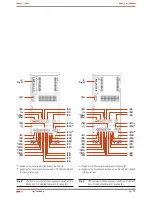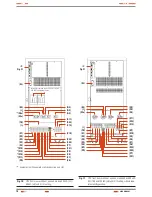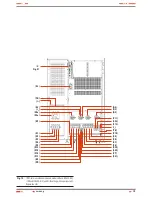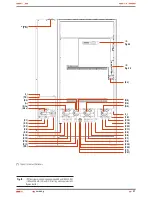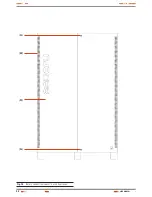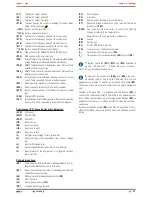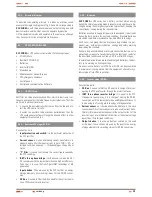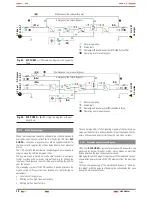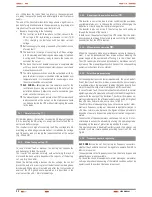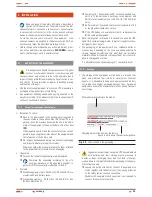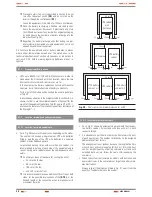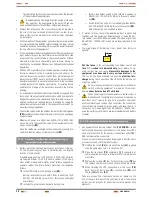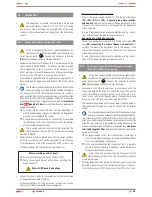
27
SALICRU
(X7)
Terminal of output phase V.
(X8)
Terminal of output phase W.
(X9)
Terminal of output neutral N.
(X10)
Terminal (copper rod) of earth bonding for load or loads
and/or battery cabinet
( )
.
(1)
(X11)
Battery positive terminal (+).
(1)
(X12)
Battery negative terminal (–).
(X14)
Terminal of static bypass phase R (-B version only).
(X15)
Terminal of static bypass phase S (-B version only).
(X16)
Terminal of static bypass phase T (-B version only).
(X17)
Terminal of static bypass neutral N (-B version only).
(1)
(X23)
Battery neutral N terminal (central tap).
(X31)
DB9 connector for COM RS-232 and RS-485 ports.
(X32)
DB9 connector for relay interface.
(X34)
Terminal strip of two terminals for temperature probe/floating
voltage. Equipments with separate battery cabinets only.
(X36
i
)
HDB15 female connector, parallel bus input. Only useful in
parallel systems connection.
(X36
o
)
HDB15 male connector, parallel bus output. Only useful in
parallel systems connection.
(X45)
Terminal strip of two terminals, auxiliary contact of output
switch. To be connected to its external homologous.
(X47)
Battery positive terminal (+) of the battery cabinet.
(X48)
Battery negative terminal (–) of the battery cabinet.
(X49)
Battery neutral terminal N of the battery cabinet (central
tap).
(X50)
External EPO terminals.
(X51)
Terminal strip of two terminals, auxiliary contact of manual by-
pass switch. To be connected to its external homologous.
Control panel (PC), keypad and optical indicators:
(LCD)
LCD panel.
(ENT)
Key «ENTER».
(ESC)
Key «ESC».
(
)
Key move up.
(
)
Key move down.
(
)
Key move to right.
(
)
Key move to left.
(a)
Rectifier input voltage correct (green led).
(b)
Output voltage of the equipment from bypass (orange
led).
(c)
Inverter ON (green led).
(d)
Output voltage from batteries -mains fault- (red led).
(e)
General alarm of the equipment, it is triggered with any
alarm (red led).
Other abbreviations:
(BC)
Communication BUS bundle between equipments, of 5 m.
length with HDB15 connectors in both ends.
(BF)
Rod to fix the connection wires of the equipment or battery
cabinet by means of wraps.
(BL)
Mechanical lock for manual bypass switch
(Q5)
.
(CL)
Front door lock.
(LL)
Key to lock and unlock
(CL)
.
(PB)
Levellers and fixing elements.
(PC)
Control panel.
(PF)
Front door.
(PR)
Cable gland or bushing to enter the cables.
(PT)
Cable in a bridge mode way to close the circuit between
both pins of
(X45)
.
(R103)
Two wires bundle with probe, to control the floating
voltage according to the temperature.
Equipments with separate battery cabinet only.
(RD)
Casters.
(RV)
Cooling grid.
(SL)
Slot for SICRES card (option).
(TB)
Terminal cover -connection elements-.
(t
1
)
Fixing screws for terminal cover
(TB)
.
(t
2
)
Fixing screws for mechanical locking
(BL)
of switch
(Q5)
.
(1)
:
Battery terminals
(X11)
,
(X12)
and
(X23
) available in
models > 20 kVA (LV) / > 40 kVA (HV) only, or in equip-
ments B1 type (extended back up time).
By means of the connectors
(X36
i
)
and
(X36
o
)
the com-
munication loop or ring is closed between two or more
equipments connected in parallel, by means of the bundle
(BC)
.
These connectors are not useful when there is a single equipment
only.
Together with each UPS, it is supplied only one bundle
(BC)
to
connect the communication BUS. Therefore in any parallel system
there will be the same quantity of communication bundles
(BC)
as
equipments there are, so it makes possible to close the communi-
cation loop.
Each communication bundle
(BC)
has 5 metres length and it is pro-
vided with HDB15 connectors at both ends, one male and another
female.





